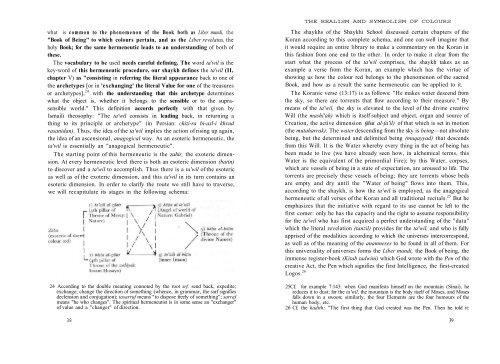Temple and Contemplation brings together for the first ... - ImagoMundi
Temple and Contemplation brings together for the first ... - ImagoMundi
Temple and Contemplation brings together for the first ... - ImagoMundi
You also want an ePaper? Increase the reach of your titles
YUMPU automatically turns print PDFs into web optimized ePapers that Google loves.
THE REALISM AND SYMBOLISM OF COLOURS<br />
what is common to <strong>the</strong> phenomenon of <strong>the</strong> Book both as Liber mundi, <strong>the</strong><br />
"Book of Being" to which colours pertain, <strong>and</strong> as <strong>the</strong> Liber revelatus, <strong>the</strong><br />
holy Book; <strong>for</strong> <strong>the</strong> same hermeneutic leads to an underst<strong>and</strong>ing of both of<br />
<strong>the</strong>se.<br />
The vocabulary to be used needs careful defining. The word ta'wil is <strong>the</strong><br />
key-word of this hermeneutic procedure, our shaykh defines <strong>the</strong> ta'wil (II,<br />
chapter V) as "consisting in referring <strong>the</strong> literal appearance back to one of<br />
<strong>the</strong> archetypes [or in 'exchanging' <strong>the</strong> literal Value <strong>for</strong> one of <strong>the</strong> treasures<br />
or archetypes], 24 with <strong>the</strong> underst<strong>and</strong>ing that this archetype determines<br />
what <strong>the</strong> object is, whe<strong>the</strong>r it belongs to <strong>the</strong> sensible or to <strong>the</strong> suprasensible<br />
world." This definition accords perfectly with that given by<br />
Ismaili <strong>the</strong>osophy: "The ta'wil consists in leading back, in returning a<br />
thing to its principle or archetype" (in Persian: chizi-ra bi-asl-i khvud<br />
rasanidan). Thus, <strong>the</strong> idea of <strong>the</strong> ta'wil implies <strong>the</strong> action of rising up again,<br />
<strong>the</strong> idea of an ascensional, anagogical way. As an esoteric hermeneutic, <strong>the</strong><br />
ta'wil is essentially an "anagogical hermeneutic".<br />
The starting point of this hermeneutic is <strong>the</strong> zahir, <strong>the</strong> exoteric dimension.<br />
At every hermeneutic level <strong>the</strong>re is both an esoteric dimension (batin)<br />
to discover <strong>and</strong> a ta'wil to accomplish. Thus <strong>the</strong>re is a ta'wil of <strong>the</strong> esoteric<br />
as well as of <strong>the</strong> exoteric dimension, <strong>and</strong> this ta'wil in its turn contains an<br />
esoteric dimension. In order to clarify <strong>the</strong> route we still have to traverse,<br />
we will recapitulate its stages in <strong>the</strong> following schema:<br />
24 According to <strong>the</strong> double meaning connoted by <strong>the</strong> root srf. send back, expedite;<br />
exchange; change <strong>the</strong> direction of something (whence, in grammar, <strong>the</strong> sarf signifies<br />
declension <strong>and</strong> conjugation); tasarruf means "to dispose freely of something"; sarraf<br />
means "he who changes". The spiritual hermeneutist is in some sense an "exchanger"<br />
of value <strong>and</strong> a "changer" of direction.<br />
38<br />
The shaykhs of <strong>the</strong> Shaykhi School discussed certain chapters of <strong>the</strong><br />
Koran according to this complete schema, <strong>and</strong> one can well imagine that<br />
it would require an entire library to make a commentary on <strong>the</strong> Koran in<br />
this fashion from one end to <strong>the</strong> o<strong>the</strong>r. In order to make it clear from <strong>the</strong><br />
start what <strong>the</strong> process of <strong>the</strong> ta'wil comprises, <strong>the</strong> shaykh takes as an<br />
example a verse from <strong>the</strong> Koran, an example which has <strong>the</strong> virtue of<br />
showing us how <strong>the</strong> colour red belongs to <strong>the</strong> phenomenon of <strong>the</strong> sacred<br />
Book, <strong>and</strong> how as a result <strong>the</strong> same hermeneutic can be applied to it.<br />
The Koranic verse (13:17) is as follows: "He makes water descend from<br />
<strong>the</strong> sky, so <strong>the</strong>re are torrents that flow according to <strong>the</strong>ir measure." By<br />
means of <strong>the</strong> ta'wil, <strong>the</strong> sky is elevated to <strong>the</strong> level of <strong>the</strong> divine creative<br />
Will (<strong>the</strong> mashi'ah) which is itself subject <strong>and</strong> object, organ <strong>and</strong> source of<br />
Creation, <strong>the</strong> active dimension (jihat al-fa'il) of that which is set in motion<br />
(<strong>the</strong> mutaharrak). The water descending from <strong>the</strong> sky is being—not absolute<br />
being, but <strong>the</strong> determined <strong>and</strong> delimited being (muqayyad) that descends<br />
from this Will. It is <strong>the</strong> Water whereby every thing in <strong>the</strong> act of being has<br />
been made to live (we have already seen how, in alchemical terms, this<br />
Water is <strong>the</strong> equivalent of <strong>the</strong> primordial Fire); by this Water, corpses,<br />
which are vessels of being in a state of expectation, are aroused to life. The<br />
torrents are precisely <strong>the</strong>se vessels of being; <strong>the</strong>y are torrents whose beds<br />
are empty <strong>and</strong> dry until <strong>the</strong> "Water of being" flows into <strong>the</strong>m. This,<br />
according to <strong>the</strong> shaykh, is how <strong>the</strong> ta'wil is employed, as <strong>the</strong> anagogical<br />
hermeneutic of all verses of <strong>the</strong> Koran <strong>and</strong> all traditional recitals. 25 But he<br />
emphasizes that <strong>the</strong> initiative with regard to its use cannot be left to <strong>the</strong><br />
<strong>first</strong> comer: only he has <strong>the</strong> capacity <strong>and</strong> <strong>the</strong> right to assume responsibility<br />
<strong>for</strong> <strong>the</strong> ta'wil who has <strong>first</strong> acquired a perfect underst<strong>and</strong>ing of <strong>the</strong> "data"<br />
which <strong>the</strong> literal revelation (tanzil) provides <strong>for</strong> <strong>the</strong> ta'wil, <strong>and</strong> who is fully<br />
apprised of <strong>the</strong> modalities according to which <strong>the</strong> universes intercorrespond,<br />
as well as of <strong>the</strong> meaning of <strong>the</strong> anamneses to be found in all of <strong>the</strong>m. For<br />
this universality of universes <strong>for</strong>ms <strong>the</strong> Liber mundi, <strong>the</strong> Book of being, <strong>the</strong><br />
immense register-book (Kitab tadwini) which God wrote with <strong>the</strong> Pen of <strong>the</strong><br />
creative Act, <strong>the</strong> Pen which signifies <strong>the</strong> <strong>first</strong> Intelligence, <strong>the</strong> <strong>first</strong>-created<br />
Logos. 26<br />
25Cf. <strong>for</strong> example 7:143: when God manifests himself on <strong>the</strong> mountain (Sinai), he<br />
reduces it to dust; <strong>for</strong> <strong>the</strong> ta'wil, <strong>the</strong> mountain is <strong>the</strong> body itself of Moses, <strong>and</strong> Moses<br />
falls down in a swoon; similarly, <strong>the</strong> four Elements are <strong>the</strong> four humours of <strong>the</strong><br />
human body, etc.<br />
26 Cf. <strong>the</strong> hadith: "The <strong>first</strong> thing that God created was <strong>the</strong> Pen. Then he told it:<br />
39

















